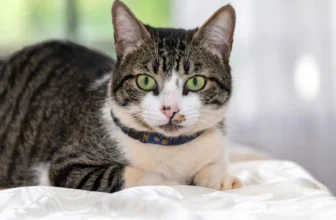As a proud American Wirehair owner, it’s heartbreaking to see your pet suffer from allergies. Allergies can cause irritation and discomfort to your beloved furry friend. Identifying and managing common allergies in American Wirehairs can be challenging, but with the right knowledge and approach, it’s possible. In this article, we will discuss tips and tricks for managing your American Wirehair’s allergies, including preventative measures and treatment options. By following these steps, you’ll be able to keep your cat happy, healthy, and allergy-free.
Identifying Common Allergies in American Wirehairs

For American Wirehair cat owners, it’s essential to be aware of common allergies that may affect their pets. Identifying the problem at an early stage can help in timely treatment and avoiding the escalation of the condition. In this section, we will discuss several allergies that American Wirehairs are prone to and ways to spot them. This information can be valuable to ensure the health and well-being of your feline friend. So, let’s dive in without any delay.
Flea Allergy Dermatitis
Flea allergy dermatitis is one of the most common allergies found in American Wirehairs. The allergy is caused by the saliva of fleas and can cause intense itching and scratching in affected cats.
Identifying Flea Allergy Dermatitis: If you notice that your American Wirehair is scratching excessively, biting, or licking its skin, there is a good chance that the cat may have flea allergy dermatitis. You may also see small red bumps on the cat’s skin or find flea dirt on its fur.
Prevention and Treatment: The best way to manage flea allergy dermatitis is to prevent flea infestations altogether. Use flea preventatives, such as spot treatments, collars, and flea combs, to keep fleas away. It’s important to keep your cat and its environment clean to prevent fleas from proliferating. Vacuuming frequently, washing bedding, and grooming can help eliminate fleas.
If your cat does have flea allergy dermatitis, topical treatments can help manage symptoms. Consider using anti-itch creams or medicated shampoos to reduce skin irritation. Oral medications, such as antihistamines or steroids, can also be effective in reducing symptoms.
Internal link: It’s important to note that fleas can also cause other issues for your American Wirehair, such as intestinal parasites. Read more about GI problems in American Wirehairs to learn more about preventing and treating these issues.
Inhalant Allergies
Inhalant allergies, also known as atopy, occur when a cat inhales allergens from the environment. Common inhalant allergens include pollen, dust mites, mold spores, and dander from other animals. Symptoms of inhalant allergies in American Wirehairs may include incessant scratching, biting, and chewing of the skin, red and inflamed skin, and hair loss.
Here are some tips and tricks to manage inhalant allergies in American Wirehairs:
- Reduce your cat’s exposure to allergens by using air filters in your home. Look for filters that use HEPA technology to capture the smallest particles.
- Frequent cleaning of your home and cat’s bedding is vital in reducing the amount of allergens present.
- Bathing your cat regularly with a mild soap can reduce the amount of allergens on their fur.
- There are various types of medicated shampoos available that can help soothe irritated skin of your American Wirehair.
- It’s important to minimize your cat’s exposure to outdoor allergens. Keep them inside as much as possible and avoid going outside during periods of high pollen count.
- Regular veterinary check-ups will help to identify whether the cause of your cat’s symptoms is seasonal allergies or another underlying condition that may need veterinary intervention.
If your American Wirehair is experiencing symptoms of inhalant allergies, it’s essential to take action promptly. Untreated allergies can lead to an increased risk of secondary bacterial and yeast infections. In some cases, the use of antihistamines and corticosteroids may be prescribed by a veterinarian.
Click here to learn more about the importance of regular vet check-ups for your American Wirehair’s overall well-being.
Food Allergies
Food allergies are another common type of allergy that American Wirehairs can experience. Food allergies can cause a range of symptoms, including gastrointestinal upset, itching, and skin irritation. Some American Wirehairs may also experience chronic ear infections or hair loss due to food allergies.
Identifying Food Allergies
If you suspect that your American Wirehair has a food allergy, it is important to identify the food or ingredient that is causing the allergy. This can be done through an elimination diet, in which you gradually introduce new foods to your American Wirehair’s diet while monitoring for any allergic reactions.
Common Food Allergens for Cats
There are several common food allergens for cats, including:
| Food Allergen | Description |
|---|---|
| Beef | May cause gastrointestinal upset and skin irritation. |
| Chicken | May cause gastrointestinal upset, itching, and skin irritation. |
| Dairy | May cause gastrointestinal upset and skin irritation. |
| Wheat | May cause gastrointestinal upset, itching, and skin irritation. |
| Corn | May cause gastrointestinal upset, itching, and skin irritation. |
Preventing Food Allergies
Preventing food allergies in American Wirehairs can be done by providing a balanced and varied diet that is free from common food allergens. By feeding your American Wirehair a high-quality, grain-free cat food with a protein source that they have not eaten before, you can reduce the likelihood of them developing a food allergy. Additionally, avoiding feeding your American Wirehair table scraps and human food can also help prevent food allergies.
If you suspect that your American Wirehair has a food allergy, it is important to consult with your veterinarian to determine the best course of action.
By being mindful of the various types of allergies that American Wirehairs are prone to, such as flea allergy dermatitis, inhalant allergies, and food allergies, you can take steps to prevent and manage these allergies. With proper prevention and treatment, you can help ensure that your American Wirehair leads a healthy and happy life. For more information on keeping your American Wirehair healthy, check out our other articles on topics such as preventing hairballs, dental care, ear infections, and maintaining a healthy weight.
Contact Allergies
Contact allergies in American Wirehairs occur when their skin comes into contact with a specific substance that they are allergic to. This can include anything from grooming products to household chemicals, fabrics, and even plants. Symptoms of contact allergies may include intense itching, redness, swelling, and sometimes blistering. Contact allergies can be very uncomfortable for our feline friends, and as a responsible pet owner, it is important to learn how to prevent and treat them. Here are some tips:
1. Identify the source of the allergy: If you suspect your American Wirehair has a contact allergy, the first thing you need to do is try and identify the source of the allergy. Start by thinking of any changes in their environment, such as new cleaning products or grooming products. Observe their behavior to see if they scratch or rub against something specific.
2. Minimize exposure: Once you have identified the allergen, be sure to eliminate it from your cat’s environment. This can be done by removing the item or substance that caused the allergy or by preventing access to it. For example, if your cat is allergic to a plant, keep the plant out of their reach or remove it entirely.
3. Use hypoallergenic products: If your cat has a contact allergy to a specific grooming product, try switching to a hypoallergenic alternative. Hypoallergenic products are specifically designed for cats with sensitive skin, making them less likely to cause an allergic reaction.
4. Consult with a veterinarian: If your cat’s contact allergy is severe or does not improve with the above steps, it is essential to consult with a veterinarian. They may prescribe antihistamines or topical treatments to help relieve symptoms and prevent further irritation.
By following these tips, you can help prevent and treat contact allergies in your American Wirehair, ensuring that they are comfortable and happy in their environment. Remember, a healthy and happy cat is a joy to have around.
Preventing Common Allergies in American Wirehairs

As a pet owner, preventing common allergies in your American Wirehair cat is crucial to ensure their well-being. Fortunately, there are several measures you can take to minimize the risk of allergies affecting your feline friends. By taking proactive steps such as implementing flea prevention and practicing safe cleaning habits, you can help your American Wirehair enjoy a happy and healthy life free of common allergies. Let’s explore some of the top tips for preventing allergies in American Wirehairs.
Flea Prevention
Fleas are a common problem among American Wirehairs, and flea bites can lead to flea allergy dermatitis. To prevent flea infestations, it’s important to take preventative measures. Here are some tips to help prevent fleas and protect your cat:
| Tip | Description |
|---|---|
| Regular grooming | Grooming your cat on a regular basis can help you detect fleas early and can also help control the population. Use a flea comb and groom your cat’s fur thoroughly. If you detect any fleas or black specks, which may be flea dirt, consult your vet for a flea treatment plan. |
| Indoor living | Limit your cat’s exposure to outdoor activities as much as possible. Flea infestations usually begin outdoors and then get carried inside. If your cat goes outdoors, regularly check for fleas and use preventative flea treatment. |
| Regular vacuuming | Vacuum your cat’s living environment at least once a week, focusing on carpets, rugs, bedding, and furniture. This can help remove any flea eggs or larvae. After vacuuming, discard the vacuum bag or clean the bagless container to prevent re-infestation. |
| Use flea prevention products | There are a variety of flea prevention products available, including spot-on treatments, flea collars, sprays, and oral medications. Consult with your vet to determine the best flea prevention product for your American Wirehair. |
By following these tips, you can help keep your American Wirehair flea-free and reduce the risk of flea allergy dermatitis. Remember, prevention is key in managing flea infestations and protecting your cat’s health.
Indoor Air Quality
Maintaining good indoor air quality can significantly reduce the chances of respiratory allergies in your American Wirehair. Here are some tips to improve the quality of indoor air your cat is breathing:
| Tip | Description |
|---|---|
| Keep the House Clean | Regularly cleaning the house helps to remove dust, pollen, and dander, which can be allergens. Use a vacuum cleaner with a HEPA filter to trap dust and pet hair effectively. Clean your cat’s bed, toys, and litter box regularly, as they can also harbor allergens. |
| Minimize Humidity | High humidity levels can create a favorable environment for mold, bacteria, and dust mites, which can be allergenic. Keep the humidity level below 50% by using a dehumidifier or air conditioner. |
| Air Purification | Air purifiers with HEPA filters can effectively remove allergens from the air, such as pet dander, pollen, and dust mites. Place air purifiers in the rooms where your cat spends most of their time. |
| Avoid Smoking | Cigarette smoke contains several compounds that can cause respiratory allergies in cats. Avoid smoking in the house or around your cat. If you have guests who smoke, ask them to smoke outside. |
| Use Fragrance-Free Products | Fragrance-containing products, such as air fresheners, cleaning agents, and soaps, can cause respiratory allergies in cats. Use fragrance-free products whenever possible. |
Improving indoor air quality is an essential step in reducing the risk of respiratory allergies in American Wirehairs. By following these tips, you can ensure that your cat is breathing in clean, fresh air and is less likely to develop allergic reactions.
Proper Nutrition
One of the best ways to prevent common allergens in American Wirehairs is through proper nutrition. Good nutrition can help boost the immune system and reduce the risk of allergies. Here are some tips for ensuring your cat has proper nutrition:
- Feed high-quality cat food: Look for cat food that is high in protein and low in fillers and additives. Avoid products with artificial flavors, colors, and preservatives. Make sure the food contains essential nutrients, such as omega-3 fatty acids and vitamin E, which can help support your cat’s immune system.
- Introduce a limited ingredient diet: If your cat has food allergies, consider a limited ingredient diet. This type of diet contains only a few ingredients, making it easier to identify the allergen and eliminate it from the cat’s diet.
- Hydrate your cat: Keep your cat well-hydrated by providing fresh, clean water at all times. Add water to your cat’s wet food to increase their fluid intake.
- Give treats in moderation: Treats should be given in moderation and should not constitute a large portion of your cat’s diet. Look for healthy treat options or make your own treats at home.
- Consult with your veterinarian: Your veterinarian can recommend the best diet for your cat based on their specific needs and health conditions. They can also provide guidance on feeding schedules and portion sizes.
It’s important to note that while proper nutrition can help prevent allergies, it may not completely eliminate the risk. If your cat is still experiencing allergy symptoms, it’s important to seek veterinary care and explore other prevention methods.
Safe Cleaning Practices
Cleaning is an essential aspect of maintaining a healthy living environment for both you and your American Wirehair. However, certain cleaning practices can be harmful and may trigger allergies in sensitive cats. Here are some safe cleaning practices you can adopt to prevent common allergies in American Wirehairs:
- Use pet-friendly cleaning products: Some cleaning products contain harsh chemicals that might trigger an allergic reaction in your American Wirehair. Always check the label of cleaning products to ensure that they are pet-friendly before use. Alternatively, you can opt for natural cleaning agents such as baking soda and vinegar which are non-toxic and safe for pets.
- Clean regularly: Cleaning regularly helps prevent the buildup of dust, pollen, and other allergens that might trigger an allergic reaction in your cat. Ensure you clean your house and your cat’s litter box frequently. Aim to clean at least twice a week.
- Vacuum often: Vacuuming helps reduce the amount of dirt and dust in your home. Use a vacuum with a HEPA filter to trap allergens such as dust, pet dander, and pollen. Pay particular attention to areas where your American Wirehair spends most of their time.
- Avoid air fresheners and scented candles: While air fresheners and scented candles might make your home smell nice, they can be harmful to your American Wirehair. These products contain volatile organic compounds (VOCs) which can trigger allergies and respiratory problems in cats. Instead, opt for natural alternatives such as essential oils or open windows to ventilate your home.
- Wash your cat’s bedding regularly: Your cat’s bedding can trap allergens such as pet dander and dust. Ensure you wash your cat’s bedding, blankets, and other fabrics that your cat frequently comes into contact with at least once a week using pet-friendly detergent.
By adopting these safe cleaning practices, you can reduce the likelihood of your American Wirehair developing an allergic reaction to harsh chemicals or allergens in your home.
Avoiding Irritants
As an American Wirehair owner, it’s important to be mindful of potential irritants that could trigger allergies in your pet. Here are some preventative measures you can take to avoid exposing your furry friend to unnecessary irritants:
- Avoid smoking near your pet: Cigarette smoke is a common irritant that can cause respiratory issues and exacerbate allergies. If you’re a smoker, try to avoid smoking around your American Wirehair. Better yet, consider quitting altogether for the health of both you and your pet.
- Use unscented litter: Many kinds of kitty litter contain fragrances that can irritate an animal’s sensitive respiratory system. Opt for unscented litter to reduce the chances of triggering allergies.
- Choose fragrance-free cleaning products: Just like with litter, some cleaning products contain strong fragrances that can make your cat sneeze, cough, or experience other allergy symptoms. Stick to fragrance-free products to minimize the risk of your American Wirehair having an allergic reaction.
- Keep harsh chemicals out of reach: Chemicals like bleach, ammonia, and other household cleaning agents can be harmful to your pet if ingested. Keep them out of reach and make sure they’re properly labeled to prevent any accidental exposure.
- Avoid strong-smelling perfumes and colognes: Just as with cleaning products, strong perfumes and colognes can be problematic for cats. Avoid spraying these products around your American Wirehair to prevent allergic reactions.
By taking a few simple steps to avoid irritants, you can reduce the risk of your American Wirehair experiencing allergies and improve their overall health and wellbeing.
Treating Common Allergies in American Wirehairs

Managing common allergies in American Wirehairs can be a challenging and frustrating experience for both pet owners and their furry friends. In some cases, preventing allergies isn’t always possible, causing our four-legged companions to suffer from various uncomfortable symptoms. Luckily, treating allergies in American Wirehairs is not impossible, and there are several remedies available to help alleviate and manage these symptoms. In this section, we’ll explore some of the most effective treatments available for managing common allergies in American Wirehairs. So, let’s dive right in!
Topical Treatments
When managing common allergies in American Wirehairs, topical treatments can be used to help relieve symptoms. These treatments often come in the form of sprays, shampoos, or creams, and are applied directly to the affected area. Here are some effective topical treatments for common allergies in American Wirehairs:
| Treatment | Description |
|---|---|
| Hydrocortisone cream | Reduces itching and inflammation caused by flea allergy dermatitis or contact allergies. Only use as directed by your veterinarian as overuse may cause thinning of the skin. |
| Antibacterial shampoo | Helps to soothe skin irritations and prevent secondary infections caused by excessive scratching. Look for a shampoo that contains chlorhexidine or benzoyl peroxide. |
| Calming sprays | Contain natural ingredients such as lavender or chamomile to help soothe irritated skin and reduce itching. These sprays can be applied to bedding or directly onto the affected area. |
| Oatmeal bath | A natural remedy that can help to soothe skin irritation and itching. Look for an oatmeal-based shampoo or make your own by blending oatmeal into a fine powder and adding it to your pet’s bath water. |
It’s important to note that while topical treatments can be helpful in providing relief, they should not be used as a long-term solution. If your pet’s symptoms persist or worsen, it’s important to seek veterinary care. Additionally, be sure to consult with your veterinarian before using any new products on your pet, as they may have individual allergies or sensitivities.
Oral Medications
Oral medications can be very effective in managing common allergies in American Wirehairs. There are several types of medications that can help reduce allergic reactions in cats.
Antihistamines: These are used to block the effects of histamine that is produced during an allergic reaction. Antihistamines can help control itching, sneezing, and other symptoms of allergies. Some commonly used antihistamines for cats include diphenhydramine, chlorpheniramine, and cetirizine.
Corticosteroids: These medications can be given orally or as an injection. Corticosteroids work by reducing inflammation and suppressing the immune system response that causes allergic reactions. They can control itching, swelling, and other symptoms of allergies. However, corticosteroids can have side effects if used long-term and should only be used under the supervision of a veterinarian.
Cyclosporine: Cyclosporine is an immunosuppressive drug that can be used to treat inflammatory conditions such as allergies. It works by reducing the activity of certain immune cells that are responsible for causing allergic reactions. Cyclosporine can take several weeks to start working and may require blood tests to monitor its effectiveness and any side effects.
Omega-3 Fatty Acids: Omega-3 fatty acids are natural anti-inflammatory agents that can be found in fish oil supplements and some prescription diets. They can help reduce inflammation and soothe itchy skin caused by allergies.
It is important to note that oral medications should only be used under the guidance of a veterinarian. Some medications can have side effects or interact with other medications, so it is essential to discuss the risks and benefits with a professional. In some cases, a combination of medications may be necessary to manage a cat’s allergies effectively.
Allergy Shots
Allergy shots, also known as immunotherapy, can be a very effective treatment option for American Wirehairs suffering from allergies. This treatment involves injecting small amounts of the allergen into the cat’s body over a period of time, gradually increasing the dose until the immune system becomes desensitized. This is a long-term treatment that can take several months to years, but it can greatly reduce the severity of allergic reactions.
How Allergy Shots Work:
Allergy shots work by exposing the cat’s immune system to small amounts of the allergen. Over time, this helps the immune system build up a tolerance to the allergen, reducing the severity of allergic reactions. The treatment usually involves two phases: the buildup phase and the maintenance phase.
The Buildup Phase:
During the buildup phase, the cat is given injections of the allergen one to two times a week. The dose is gradually increased over several months until the maximum tolerated dose is reached. This phase usually lasts about three to six months.
The Maintenance Phase:
During the maintenance phase, the cat continues to receive injections of the allergen, but at a slower frequency, usually every two to four weeks. The dose remains the same as in the buildup phase. This phase can last for several years, depending on the cat’s response to the treatment.
Benefits of Allergy Shots:
Allergy shots have several benefits for American Wirehairs suffering from allergies:
-Reduced reliance on medications: Allergy shots can greatly reduce the need for medication to manage allergies.
-Long-lasting relief: Unlike medications, the effects of allergy shots can last for several years.
-Reduced allergic reactions: Allergy shots can reduce the severity of allergic reactions, making them less frequent and less intense.
Are Allergy Shots Right for Your American Wirehair?
Allergy shots are not always the best treatment option for every cat suffering from allergies. It’s important to speak with your veterinarian to determine if allergy shots are appropriate for your American Wirehair. They may recommend a different treatment option based on your cat’s individual needs and medical history.
Allergy shots can be an effective long-term treatment option for American Wirehairs with allergies. It’s important to work closely with your veterinarian to determine the best treatment plan for your cat. With proper management and treatment, your American Wirehair can live a happy, healthy life, free from the discomfort of allergies.
Elimination Diet
An elimination diet is an effective way of determining if your American Wirehair has a food allergy. This diet involves removing all potential allergens from your cat’s diet and then gradually reintroducing them to identify the culprit.
Steps for implementing an elimination diet:
| Step | Description |
|---|---|
| Consult with your vet | Before starting an elimination diet, talk to your vet to ensure it’s safe for your cat. |
| Choose a protein and carb source | Choose a protein and carbohydrate source that your cat has never eaten before. Good options include duck and potato or venison and peas. |
| Transition to the new food | Gradually introduce the new food over the course of a week by mixing a small amount into your cat’s usual food. |
| Evaluate results | Monitor your cat for several weeks to evaluate any changes in symptoms. If there’s an improvement, you’ll know your cat has a food intolerance and can systematically reintroduce new ingredients. |
| Reintroduce potential allergens | One at a time, reintroduce ingredients from your cat’s old diet and monitor your cat for any symptoms. If an ingredient causes a reaction, remove it from the diet immediately. |
It’s important to note that elimination diets require patience and time to be effective. You may need to try different protein and carbohydrate sources to find the right combination for your cat. By working closely with your vet, you can develop a new diet that meets all of your cat’s nutritional needs while avoiding their allergens.
When to Seek Veterinary Care
While home remedies can help manage some common allergies in American Wirehairs, it’s important to know when to seek veterinary care. Your pet may require more specialized treatment or prescription medication to alleviate their discomfort.
Severe Symptoms
If your American Wirehair exhibits severe allergy symptoms, such as vomiting, diarrhea, excessive scratching, or difficulty breathing, it’s critical to seek veterinary care right away. These symptoms can be indicative of an anaphylactic reaction, which can be life-threatening.
Persistent Symptoms
If your pet’s allergy symptoms persist despite your best efforts to manage them with at-home remedies, you should consult with your vet. Your pet may need prescription medication or a more targeted treatment plan to alleviate their discomfort.
Recurrent Infections
If your American Wirehair experiences frequent ear or skin infections as a result of their allergies, it may be time to involve a veterinarian. Chronic infections can lead to more severe health problems, so early intervention is key.
Preventative Care
Veterinarians can also help you prevent common allergies in American Wirehairs by recommending specific dietary changes, supplements, or preventative medications. Regular check-ups and communication with your vet can help you stay ahead of any potential health issues that may arise.
If you notice any severe or persistent symptoms in your American Wirehair, seeking veterinary care is the best course of action. Your vet can provide effective treatment options to alleviate your pet’s discomfort and improve their overall health and quality of life.
Conclusion
In conclusion, managing and preventing common allergies in American Wirehairs requires a comprehensive approach. Flea allergy dermatitis, inhalant allergies, food allergies, and contact allergies are all potential triggers, and it is important to identify the specific cause in order to treat it properly. Prevention measures such as flea prevention, maintaining good indoor air quality, providing proper nutrition, using safe cleaning practices, and avoiding irritants can all help reduce the likelihood of allergies occurring. However, if allergies do develop, there are various treatment options available including topical treatments, oral medications, allergy shots, and elimination diets. It is important to seek veterinary care if allergies are severe or persistent. By taking steps to manage and prevent allergies, American Wirehairs can enjoy a healthy and happy life.
Frequently Asked Questions
What are common symptoms of flea allergy dermatitis in American Wirehairs?
Common symptoms include excessive scratching and biting, hair loss, scabs on the skin, and a red rash on the skin.
What are common examples of inhalant allergens that affect American Wirehairs?
Examples include pollen, dust mites, mold spores, and certain types of animal dander.
Can American Wirehairs develop food allergies?
Yes, American Wirehairs can develop food allergies to proteins commonly found in beef, chicken, dairy, and grains.
What are common signs of contact allergies in American Wirehairs?
Signs include redness, itchiness, and bumps on the skin at the point of contact with the allergen, which can include certain materials or substances like cleaning products or grass.
How can flea infestations be prevented in American Wirehairs?
Flea infestations can be prevented by treating the pet with flea prevention medication, regularly cleaning and vacuuming the pet’s environment, and avoiding places where fleas are known to be present.
What can be done to improve indoor air quality and prevent inhalant allergies for American Wirehairs?
Some measures that can be taken include investing in an air purifier, regularly cleaning and vacuuming the home, and keeping windows and doors closed during high pollen seasons.
What should be included in a proper nutrition plan for American Wirehairs to prevent allergies?
A proper nutrition plan should include high-quality, hypoallergenic food containing limited ingredients that are free of common allergens like beef, chicken, and dairy.
How can safe cleaning practices help prevent allergies in American Wirehairs?
Safe cleaning practices involve using non-toxic and unscented products to avoid exposure to irritating chemicals and fragrances that can trigger allergies in pets.
What are common topical treatments used to manage allergies in American Wirehairs?
Common topical treatments include medicated shampoos, moisturizers, and sprays that can help soothe and relieve skin irritations caused by allergies.
When should American Wirehairs with allergies seek veterinary care?
American Wirehairs with allergies should seek veterinary care if their symptoms persist or worsen despite home treatments, if they exhibit signs of anaphylactic shock, or if they have difficulty breathing or experience gastrointestinal distress.







